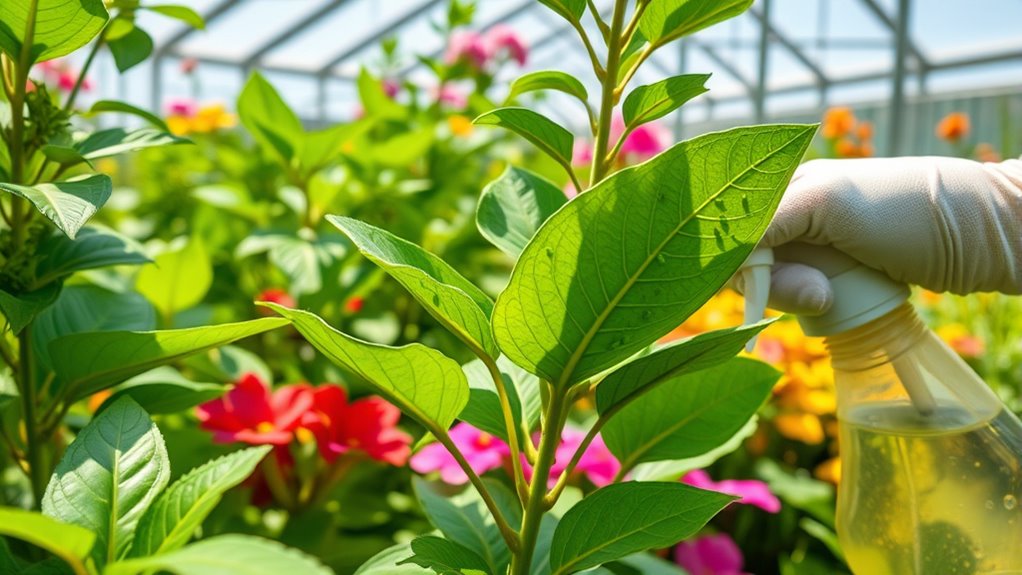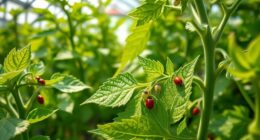In your greenhouse, common pests like aphids, whiteflies, spider mites, and mealybugs can threaten plants. To control them, identify these pests early by inspecting leaves and stems closely. Use biological controls like ladybugs and parasitic wasps, or apply organic treatments such as neem oil or insecticidal soap. Good sanitation, proper watering, and monitoring help prevent infestations. Keep exploring to discover effective strategies to keep your greenhouse healthy and pest-free.
Key Takeaways
- Common greenhouse pests include aphids, whiteflies, spider mites, mealybugs, and scale insects, identifiable by specific signs and physical features.
- Biological control using natural predators like ladybugs and predatory mites effectively manages pest populations sustainably.
- Cultural practices such as regular inspection, sanitation, and proper watering help prevent pest infestations.
- Organic pesticides like neem oil and insecticidal soaps are targeted options for controlling pests when necessary.
- Early detection and integrated pest management strategies are essential to prevent widespread damage in greenhouses.
Identifying Aphids and Effective Management Techniques
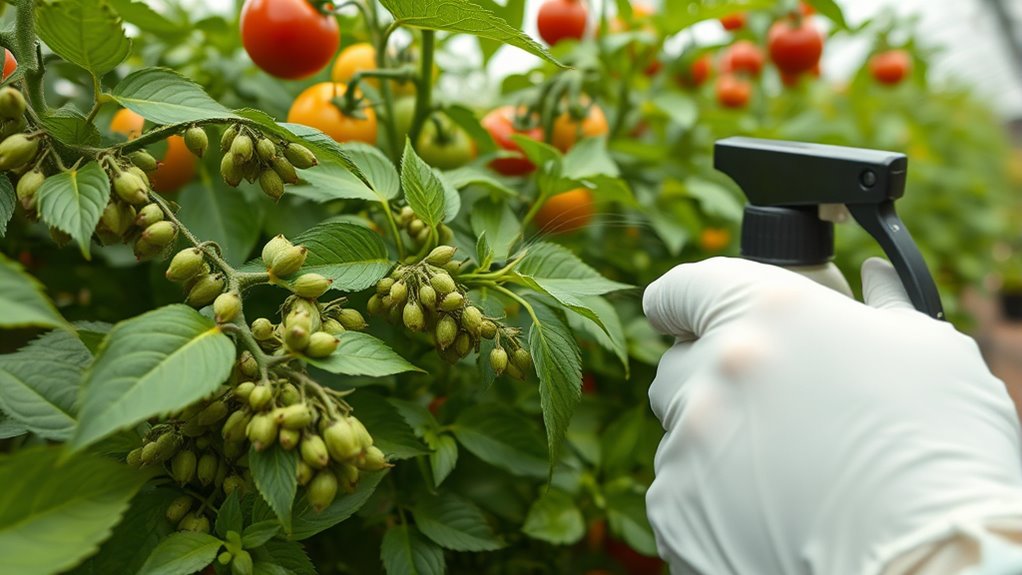
Aphids are small, soft-bodied insects that often cluster on the undersides of leaves and new growth. Recognizing these pests early is key to managing infestations effectively.
Biological control methods, such as introducing beneficial insects like ladybugs or parasitic wasps, help naturally reduce aphid populations without chemicals. These natural predators are environmentally friendly options that support sustainable gardening practices.
Introducing ladybugs and parasitic wasps naturally reduces aphid populations without chemicals.
Additionally, selecting pest resistant cultivars can considerably lower the risk of aphid problems, as these plants are bred to withstand or deter infestations. Using resistant plant varieties is a proactive approach to minimize pest issues.
Regular inspection of your plants allows you to catch aphids before they spread extensively. Employing integrated pest management strategies that combine biological control, resistant plant varieties, and proper cultural practices can be highly effective in maintaining a healthy greenhouse environment. Incorporating early detection techniques can further enhance your ability to manage pests effectively. Moreover, understanding pest behavior can help in timing control measures more effectively.
Combining biological control with resistant plant varieties offers a sustainable, eco-friendly strategy to keep aphids in check, protecting your greenhouse’s health and productivity.
Controlling Whiteflies to Protect Your Greenhouse Plants
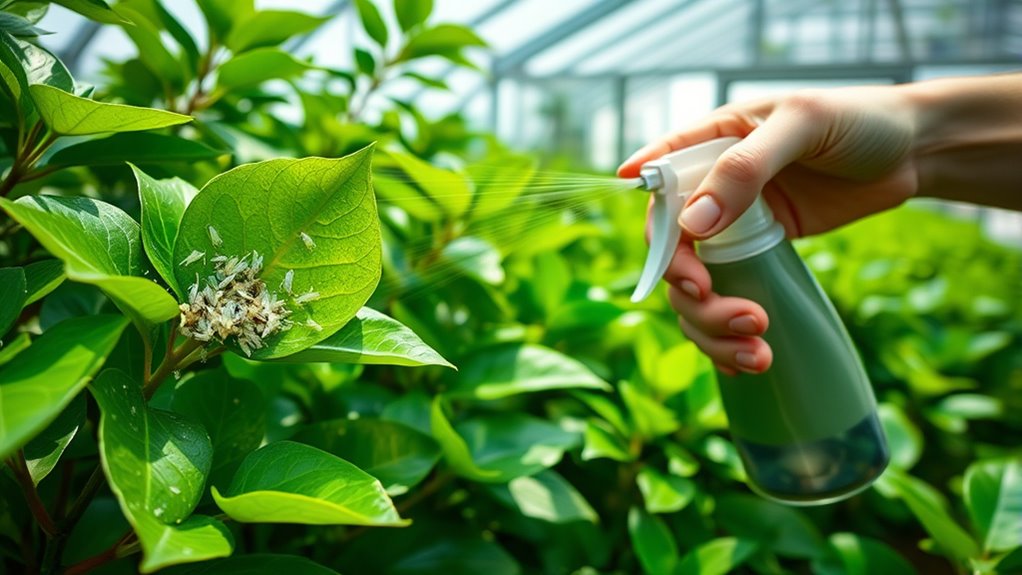
Have you noticed tiny white insects fluttering around your greenhouse plants? Whiteflies can quickly become a serious problem. To control them effectively, consider these strategies:
- Introduce natural predators like ladybugs or parasitic wasps for biological control.
- Use organic pesticides such as neem oil or insecticidal soaps, applied thoroughly on affected plants.
- Remove heavily infested leaves to reduce whitefly populations.
- Maintain proper airflow and hygiene to prevent their spread, as good greenhouse management can significantly reduce pest occurrences. Implementing integrated pest management practices can further enhance your pest control efforts.
Biological control methods are especially advantageous because they target whiteflies without harming beneficial insects or your plants. Organic pesticides provide a safe, chemical-free option that disrupts whitefly life cycles. Regular monitoring and early intervention are key to keeping these pests under control and protecting your greenhouse crops. Vetted products and techniques ensure safety for both your plants and the environment. Additionally, understanding pest behavior can help in developing more effective control strategies. Incorporating environmental conditions such as humidity and temperature management can also suppress whitefly populations effectively.
Strategies for Managing Spider Mites

Spider mites can quickly damage your greenhouse plants if left unchecked, but effective management is possible with targeted strategies. Start by introducing biological control; predatory mites like Phytoseiulus persimilis can naturally reduce spider mite populations. Release these beneficial insects early to keep infestations in check.
Additionally, environmental modification plays an essential role—maintain high humidity and avoid dry conditions, as spider mites thrive in dry environments. Regularly rinse plants with water to dislodge mites and reduce their numbers. Implementing powerful persuasive words in your communication can also help motivate timely action against pests.
Keep your greenhouse clean and free of debris, and monitor plants closely for early signs of infestation. Biological control methods such as releasing predatory mites are proven to be highly effective and environmentally friendly. Understanding the importance of environmental conditions can significantly enhance pest management strategies. For example, combining biological control with integrated pest management creates a sustainable, chemical-free approach that keeps spider mite populations under control and protects your plants effectively. Incorporating early detection techniques can further improve your ability to address infestations promptly and prevent widespread damage.
Dealing With Fungus Gnats and Soil-Borne Pests
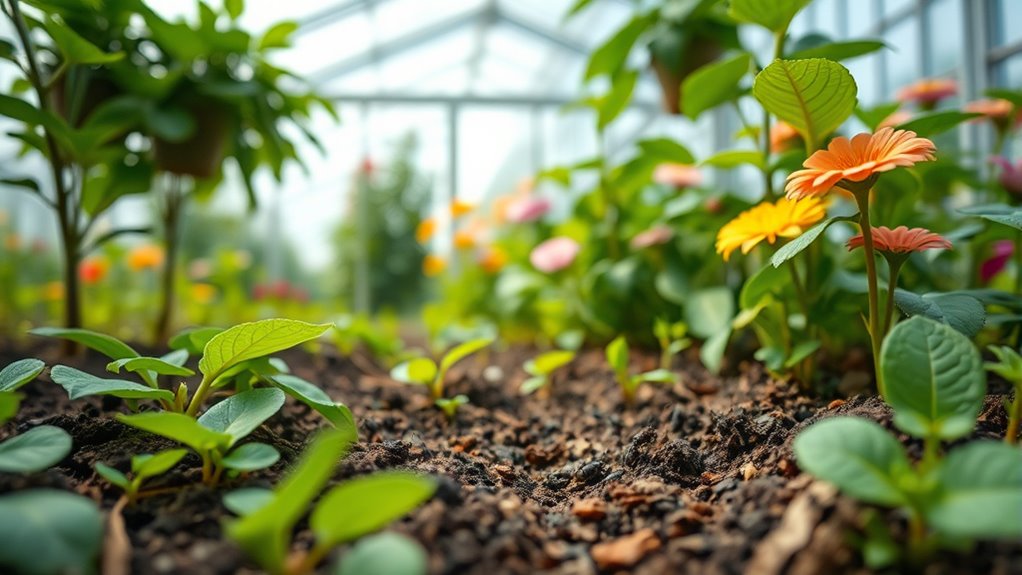
Fungus gnats and soil-borne pests can quickly damage your plants if you don’t recognize their signs early. Look for small flying insects around moist soil or tiny larvae wriggling in the top layer. Learning effective management strategies will help you keep these pests under control and protect your greenhouse. Implementing integrated pest management approaches can further enhance your ability to control these pests sustainably. Regularly inspecting your soil and plants for pest indicators ensures early detection and effective treatment. Additionally, understanding the environmental impacts of pests can guide you in adopting more sustainable control methods that minimize harm to your ecosystem. Utilizing biological controls, such as beneficial nematodes or predatory insects, can provide natural pest suppression without chemical use. Incorporating space and organization techniques, such as creating designated zones for healthy plants and compost areas, can help reduce pest habitats and improve overall pest control efforts.
Identifying Fungus Gnat Signs
Wondering how to tell if your plants are suffering from fungus gnats? Look for these signs:
- Small black flies hovering near soil surface, especially when watering.
- Sticky residue or mold on the soil, indicating high moisture levels.
- Wilting or yellowing plants despite adequate watering.
- Tiny larvae visible in the soil when disturbed, part of the fungus gnat lifecycle.
Fungus gnats thrive in moist soil, so soil moisture management is key to control. These pests lay eggs in damp soil, leading to a cycle that perpetuates infestations.
Soil Pest Management Strategies
Managing soil pests like fungus gnats and other soil-borne threats requires a combination of cultural, biological, and chemical strategies. First, focus on maintaining soil health by avoiding overwatering and ensuring proper drainage, which reduces conditions that favor pests.
Regular pest monitoring helps you catch infestations early, making control easier. Use sticky traps to monitor adult fungus gnats and identify hotspots.
Incorporate biological controls like beneficial nematodes or predatory mites to target soil-borne pests naturally. When necessary, apply targeted soil drenches with insecticidal soaps or organic alternatives to eliminate pests without harming plants.
Consistent monitoring and maintaining healthy soil are key to preventing future outbreaks and keeping your greenhouse pest-free.
Preventing and Addressing Mealybugs and Scale Insects
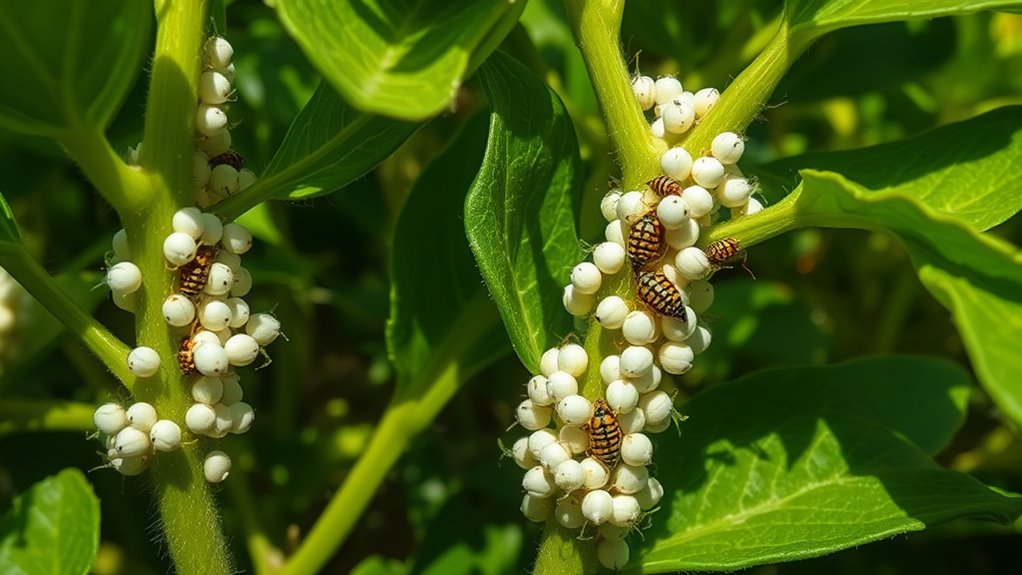
To protect your greenhouse plants, start by learning how to identify mealybugs and scale insects quickly. Recognizing their signs allows you to choose the most effective control strategies before they spread.
Let’s explore how to spot these pests and what methods work best to eliminate them.
Identifying Mealybugs and Scales
Have you ever noticed tiny, oval-shaped insects or sticky, waxy coverings on your plants? These could be signs of mealybugs or scales. To identify them accurately, look for the following:
- Mealybugs appear as white, cottony masses on stems, leaves, or roots.
- Scales look like small, rounded or oval bumps, often brown or gray, attached tightly to plant surfaces.
- Check for a sticky residue called honeydew, which encourages sooty mold growth.
- Use a magnifying glass to distinguish between the soft-bodied mealybugs and the harder scales.
Correct identification helps you choose the right control method, emphasizing biological control options and pesticide safety. Properly recognizing these pests prevents unnecessary chemical use and promotes healthier plants.
Effective Control Strategies
Preventing and addressing mealybugs and scale insects requires a proactive approach combined with targeted treatments. Start by inspecting plants regularly and removing infested material to prevent spread.
Use biological controls, like natural predators such as lady beetles and parasitic wasps, to keep populations in check without chemicals. Implement integrated pest management (IPM) strategies by combining biological controls with cultural practices, like proper watering and sanitation, to make your greenhouse less hospitable.
Applying horticultural oils or insecticidal soaps can also help manage infestations early on. Always follow label instructions and focus treatments on affected areas to minimize impact on beneficial insects.
Consistent monitoring and combining these methods will give you the best chance to control mealybugs and scale insects effectively.
Natural and Chemical Methods for Pest Prevention and Control
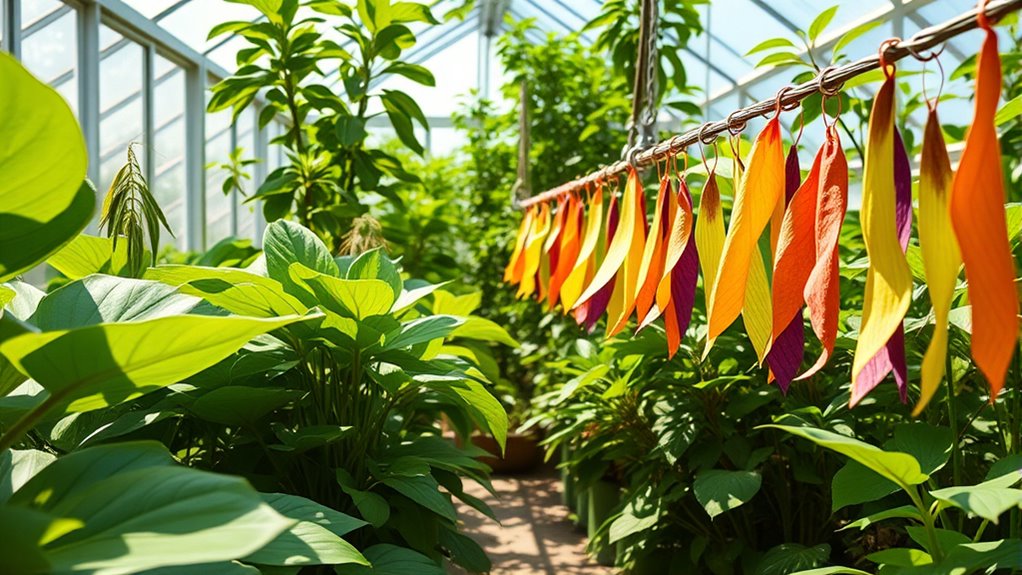
Natural and chemical methods offer effective strategies for managing greenhouse pests, giving you options to protect your plants without relying solely on one approach. You can implement:
- Companion planting to naturally repel pests and attract beneficial insects.
- Biological control, introducing predators like ladybugs or predatory mites to target specific pests.
- Organic pesticides such as neem oil or insecticidal soaps for chemical control that minimizes harm to beneficial organisms.
- Chemical treatments when necessary, using targeted pesticides carefully to avoid disrupting your ecosystem.
Combining these methods allows you to maintain a healthy greenhouse environment.
Using biological control alongside companion planting enhances pest prevention, reducing the need for harsh chemicals while promoting sustainable growth.
Frequently Asked Questions
How Can I Prevent Pests From Entering My Greenhouse Initially?
To prevent pests from entering your greenhouse, start with screening barriers at all entry points to block unwanted visitors. Conduct regular entry point inspections to catch any pests or debris before they get inside.
Keep doors and vents closed as much as possible, and clean tools and equipment before bringing them in. By maintaining these practices, you create a strong initial defense, reducing the risk of pest problems developing inside your greenhouse.
Are There Eco-Friendly Methods for Pest Control in Greenhouses?
You wonder if eco-friendly pest control methods exist. Imagine using biological controls, like releasing beneficial insects such as ladybugs to combat aphids, effectively reducing pests without chemicals.
Natural repellents, like neem oil or garlic spray, also deter pests while being safe for your plants and the environment. These methods are sustainable, minimize chemical use, and can be easily integrated into your greenhouse routine.
They help you maintain a healthy, eco-friendly growing space.
What Are the Signs of Early Pest Infestations?
You should look for early signs of pest infestations, as catching them early makes control easier. Pest indicators include tiny holes in leaves, sticky residue, or webbing on plants.
You might also notice discolored or deformed foliage. Keep a close eye on your plants regularly. Recognizing these early signs allows you to act quickly, preventing pests from spreading and causing significant damage to your greenhouse crops.
How Often Should Greenhouse Pest Inspections Be Conducted?
Pest inspection frequency is vital for keeping your greenhouse healthy. You should stick to a consistent inspection schedule, ideally checking your plants at least once a week.
Regular, routine rounds help detect pests promptly, preventing problems from spiraling out of control. By maintaining a vigilant vigilance with your inspection schedule, you can swiftly spot signs of trouble, take timely action, and keep your greenhouse thriving, pest-free, and pristine.
Can Beneficial Insects Effectively Control All Greenhouse Pests?
Beneficial insects can be highly effective for pest control, but they don’t work for every pest. You need to identify the specific pests you’re dealing with and choose the right beneficial insects to target them.
While they can markedly reduce pest populations, you might still need to combine their use with other control methods. Relying solely on beneficial insects isn’t always enough for complete pest management in your greenhouse.
Conclusion
Think of your greenhouse as a delicate ecosystem—you’re the gardener balancing pests like a tightrope walker. When I first started, a tiny aphid outbreak threatened all my plants, but with targeted control, I watched my greenhouse flourish again. Just like tending a garden requires vigilance, staying proactive against pests keeps your plants healthy. Remember, a well-managed greenhouse isn’t just about growth; it’s about nurturing resilience amid constant challenges.
